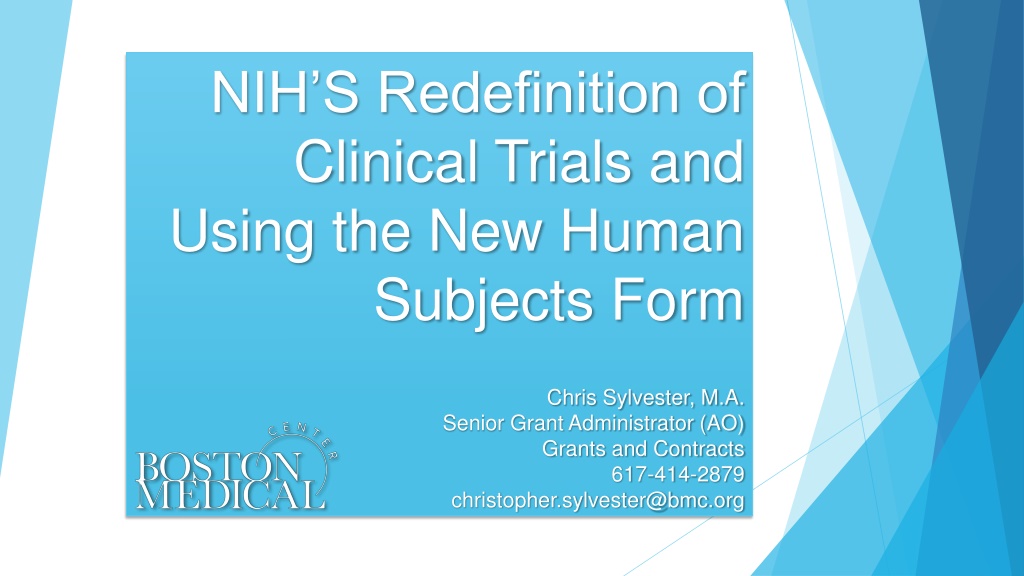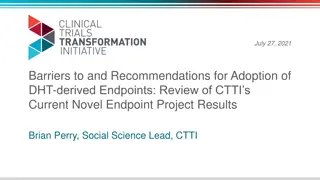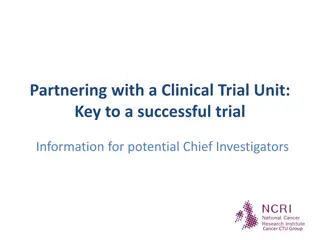Understanding NIH's Redefinition of Clinical Trials
NIH redefines clinical trials as research studies where human subjects are prospectively assigned to interventions to evaluate their effects on health-related outcomes. The criteria for defining a clinical trial by NIH include human participant involvement, prospective intervention assignment, evaluation of intervention effects on health outcomes, and the use of health-related, biomedical, or behavioral outcomes for assessment.
Download Presentation

Please find below an Image/Link to download the presentation.
The content on the website is provided AS IS for your information and personal use only. It may not be sold, licensed, or shared on other websites without obtaining consent from the author. Download presentation by click this link. If you encounter any issues during the download, it is possible that the publisher has removed the file from their server.
E N D
Presentation Transcript
NIHS Redefinition of Clinical Trials and Using the New Human Subjects Form Chris Sylvester, M.A. Senior Grant Administrator (AO) Grants and Contracts 617-414-2879 christopher.sylvester@bmc.org
NIHS REDEFINITION OF CLINICAL TRIALS A research study in which one or more human subjects are prospectively assigned (1) to one or more interventions (which may include placebo or other control) (2) to evaluate the effects of those interventions on health-related biomedical or behavioral outcomes (3). 1) The term "prospectively assigned" refers to a pre-defined process (e.g., randomization) specified in an approved protocol that stipulates the assignment of research subjects (individually or in clusters) to one or more arms (e.g., intervention, placebo, or other control) of a Clinical Trial. 2) An "intervention" is defined as a manipulation of the subject or subject s environment for the purpose of modifying one or more health-related biomedical or behavioral processes and/or endpoints. 3) A "health-related biomedical or behavioral outcome" is defined as the pre- specified goal(s) or condition(s) that reflect the effect of one or more interventions on human subjects biomedical or behavioral status or quality of life.
WHAT DOES THE NIH CONSIDER A CLINICAL TRIAL? A research study in which one or more human subjects are prospectively assigned (1) to one or more interventions (which may include placebo or other control) (2) to evaluate the effects of those interventions on health-related biomedical or behavioral outcomes (3). Each of the three components of the NIH s Clinical Trial definition are represented in the Clinical Trial Questionnaire. If all of the below questions are answered YES, your human subjects research is considered a Clinical Trial by the NIH: Example 1: The study involves the recruitment of research participants with disease X. It is designed to compare the diagnostic performance of approved devices A and B, both of which are used in clinical practice, to measure disease markers. Device A will be used in half of the patients; device B will be used in the other half. 1) Does the study involve human participants? 2) Are the participants prospectively assigned to an intervention? 3) Is the study designed to evaluate the effect of the intervention on the participants? 4) Is the effect that will be evaluated a health-related, biomedical, or behavioral outcome? This study is not considered a clinical trial: Does the study involve human participants? Yes, the study involves human participants. Are the participants prospectively assigned to an intervention? No, in this context the diagnostic device would not be considered an intervention. The purpose of the study is to evaluate the diagnostic performance of two devices, but not to determine their effects on any health-related or behavioral outcomes.
WHAT DOES THE NIH CONSIDER A CLINICAL TRIAL? A research study in which one or more human subjects are prospectively assigned (1) to one or more interventions (which may include placebo or other control) (2) to evaluate the effects of those interventions on health-related biomedical or behavioral outcomes (3). Example 2: The study involves the recruitment of research participants suspected to have disease X. It is designed to compare the ability of approved devices A and B to diagnose the disease and inform the clinical management of disease X. Device A will be used in half of the patients; device B will be used in the other half. This study IS considered a clinical trial: Does the study involve human participants? Yes. Are the participants prospectively assigned to an intervention? Yes, the participants are prospectively assigned to receive an intervention, one of two diagnostic devices. Is the study designed to evaluate the effect of the intervention on the participants? Yes, the study is designed to evaluate the ability of the two approved devices to inform the clinical management of disease X. Is the effect being evaluated a health-related biomedical or behavioral outcome? Yes, the effect being evaluated, diagnosis and clinical management of patients with disease X, is a health-related outcome.
FORMS E HUMAN SUBJECTS FORM: THE FOUR PATHS The SF424 Forms-E Grant Application now contains The PHS Human Subjects and Clinical Trials Information Form dedicated to capturing detailed information concerning human subjects research and clinical trials. All grant applications proposing studies involving human subjects or samples/data must fill out this form to some extent. The four possible uses of The PHS Human Subjects and Clinical Trials Information Form are: 1) HUMAN DATA / SAMPLES Human Subjects Front Page If No to human subjects but still using human data / samples Requires Justification 2) DELAYED ONSET STUDY Human Subjects Front Page If study cannot be defined at time of application Can be either CT or non-CT Requires Unique Title Requires Justification 3) STUDY RECORD, NON-CT At least one No on CT questionnaire Requires completion of sections 1 3 of Study Record Requires completion of Inclusion/Enrollment Report 4) STUDY RECORD, CT All answers are Yes on CT questionnaire Requires completion of sections 1 4 (and section 5 if called for by RFA) as well as Inclusion/Enrollment Report
FORMS E HUMAN SUBJECTS FORM: THE FOUR PATHS 1) HUMAN DATA / SAMPLES 2) DELAYED ONSET STUDY 3) STUDY RECORD, NON-CT 4) STUDY RECORD, CT Example 1: The study, which can be described at the time of application, involves the recruitment of research participants with disease X. It is designed to compare the diagnostic performance of approved devices A and B, both of which are used in clinical practice, to measure disease markers. Device A will be used in half of the patients; device B will be used in the other half. 3) STUDY RECORD, NON-CT Example 2: The study, which cannot be described at the time of application, involves the recruitment of research participants suspected to have disease X. It is designed to compare the ability of approved devices A and B to diagnose the disease and inform the clinical management of disease X. Device A will be used in half of the patients; device B will be used in the other half. 2) DELAYED ONSET STUDY, CT Example 3: The study involves the analysis of de-identified data gathered from subjects suspected to have disease X and who have been treated with approved devices A and B to diagnose the disease. It is designed to compare the diagnostic performance of approved devices A and B. 1) HUMAN DATA / SAMPLES
Thank You for Your Time and Participation! Chris Sylvester, M.A. Senior Grant Administrator (AO) Grants and Contracts 617-414-2879 christopher.sylvester@bmc.org























